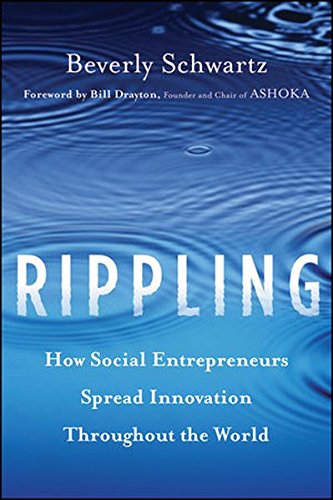Rippling: How Social Entrepreneurs Spread Innovation Throughout the World
Principles for driving significant change throughout an entire system Drawing on the knowledge and experience of working with hundreds the world’s top social change leaders in all fields, Beverly Schwartz presents a model for change based on five proven principles that any individual leader or organization can apply to bring about deep, lasting and systematic
Principles for driving significant change throughout an entire system
Drawing on the knowledge and experience of working with hundreds the world’s top social change leaders in all fields, Beverly Schwartz presents a model for change based on five proven principles that any individual leader or organization can apply to bring about deep, lasting and systematic change. Rippling shows how to activate the type of change that is needed to address the critical challenges that threaten to destroy the foundations of our society and planet in these increasingly turbulent times.
These actionable principles are brought to life by compelling real-life stories. Schwartz provides a road map that allows anyone to become a changemaker.
Presents some of today’s most innovative and effective approaches to solving social and environmental challenges Offers a vision of social entrepreneurs as role models, catalysts, enablers and recruiters who spread waves system changing solutions throughout society The author offers a model of change that begins with the end result in mind First book from an insider at Ashoka, the foremost global organization on social change through social entrepreneurship
Rippling clearly demonstrates how and when empathy, creativity, passion, and persistence are combined; significant, life-altering progress is indeed possible.
Q & A with Beverly Schwartz, author of Rippling
How did you choose which Ashoka Fellows would be featured in the book? I am privileged to know a fair number of Ashoka Fellows personally and I also had nominations from the 25 Ashoka country directors, so I was able to come up with a list of finalists that was a very balanced mix from around the world. All of them specifically illustrate one of the five approaches to system change–along with the inclusion and dependence upon many different types of changemakers as a criteria for their own successful spread of innovation. How does Rippling fit into Ashoka’s global strategy? Rippling is the first book and one of the only “products” that Ashoka has to disseminate its mission and message. Many of our global offices have used David Bornstein’s How to Change the World (2004) to help people understand what social entrepreneurship is about; Rippling will update the Ashoka story and tell a new one. Many of the country offices have been inquiring as to when the book will be available and in what languages. This is the first book entirely devoted to Ashoka and its Fellows and your first book as well after many years spent in the public and private sectors. Why now? Working at Ashoka for the past eight 8 years, I discovered the wealth of stories that existed–and at the same time realized that if we were to attain an “Everyone a Changemaker™” world (a world where everyone had the freedom and environmental, personal, and professional support to create change), a lot more people would have to be given the ability to visualize and understand what role they can play in creating that change. Over the past few years, more and more people have been attracted to the field of social entrepreneurship and intrigued with social innovation and social change. The time to write the book was right. What kind of response did you get when seeking thought leaders to write the “Reflections”? It was not as difficult as I thought it would be to get thought leaders to give their opinions to one of each of the five approaches. However, my “ask” was not random, as I did a lot of prior research on well-known and “thoughtful” people who could credibly converse on each strategy. My ask was, at the very least, grounded in subject matter compatibility. When I narrowed down my list of names, of course, it helped that for each one to the thought leaders who appear in the book, I had my one degree of separation who was willing to make the personal connection I needed to get to a “yes.” How challenging was it to work with changemakers in so many different parts of the world? With modern technology and a multilingual Ashoka staff who understood the objectives of my interviews and translated the two non-English speaking Fellows for me, it was rather seamless. I backed up each interview on both a hand recorder and on my Mac’s GarageBand application; one or the other seemed to pick up most everything I needed. Though I intended to interview everyone in person, when I physically could not, Skype did a wonderful job in connecting with Abdelfattah in Palestine (Chapter 18) and for asking clarifying questions for a few of the Fellows after the initial interviews.







Comments